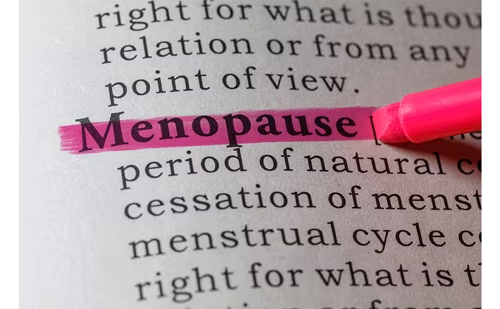Within just one century the average lifespan of women in Western countries has significantly increased and nowadays about a third of a woman’s life is lived after the menopause. This implies that the menopause is a rather new entity for humans and that the consequences of long-term life in the absence of ovarian hormones have reached their full appreciation only recently.
Within just one century the average lifespan of women in Western countries has significantly increased and nowadays about a third of a woman’s life is lived after the menopause. This implies that the menopause is a rather new entity for humans and that the consequences of long-term life in the absence of ovarian hormones have reached their full appreciation only recently.
In connection with the number of women experiencing invalidating menopausal symptoms as well as with the growing awareness of the consequences of oestrogen deprivation on the bones, the cardiovascular system and the brain, the administration of sex steroid hormones – and particularly oestrogens and progestins – to postmenopausal women became increasingly popular from the 1960s, and was named ‘hormone replacement therapy’ (HRT). The rationale for this approach has been to re-establish low but sufficient levels of sex steroids in the bloodstream of post-menopausal women to reverse the symptoms of the menopause and to possibly prevent the long-term consequences. Years of pioneering attempts to find the best possible approach to this new endeavor of endocrine therapy have gone by with the progressive trend being to lower the dose of steroids administered to women, to develop new compounds to obtain better metabolic profiles and pharmacodinamics, as well as to develop new routes of administration to increase the ease of use of these therapies as well as the patients’ compliance. In the mid-1980s countries such as the US and UK saw an incredible spread of hormone replacement after the menopause, and in some instances up to 50% of women after their last menstrual period were started on HRT by general practitioners, gynaecologists and reproductive endocrinologists. Indeed, the perception that hormonal administration was generally good for a woman’s health was at the time strong and widespread, and women associated the use of sex steroids with the idea of prolonging the youth of their bodies as well as with the preservation of their femininity after the menopause, breaking the long-standing concept that the menopause sets the time for a woman to start her ageing process.
Since then, turmoil has taken place in cultural and sociological developments in this arena, such that the history of these events makes a unique story in modern medicine, and one that is certainly worth telling.
While it has been clear from the beginning that the classical menopausal symptoms such as hot flushes, night sweats, insomnia, vaginal dryness, dyspareunia, diminished libido, urinary frequency, dry skin, weight gain, transient cognitive symptoms and altered tone of the mood could be alleviated with the use of HRT, there was a need for a clinical trial that showed objectively the long-term effects of hormonal substitution that were claimed at the beginning of the 1980s. This led to the performance of several large observational trials, such as the Nurses’ Health Study, that globally showed that long-term HRT resulted in improved skeletal health, reduced cardiovascular events, but also to a slight increase in deep vein thrombosis and stroke and possibly to a small increase in breast cancer. The medical and general perception of the balance of the effects of these therapies remained largely positive.
However, these trials suffered from one important and powerful objection raised by statisticians, known as the ‘healthy woman bias’. The bottom line that made the results of these studies in part invalid was that not being interventional trials, where women were randomly and blindly assigned to treatment or placebo, it was impossible to draw firm conclusions from the results. In addition, it was clearly appreciated that the results of the observational trials were from women that voluntarily went for consultation and accepted – and often asked for – hormonal treatment. These women were different to the average woman, being to some extent more wealthy and healthy and in general more health-conscious. Therefore the results obtained from these studies would be biased from the beginning, as one would expect less disease in these individuals than the general population.
This discussion took place at a particular moment in the evolution of modern medicine, when a pressing need for more objective validation of therapeutic interventions was strongly advocated for by health authorities, including the National Institutes of Health. This true revolution in the way medicine was investigated in its modern era was baptised as ‘evidence-based medicine’. To cut the line with the traditional approach, information from trials and clinical experience was melted into guidelines and recommendations.
This new attitude led the way to a number of trials that were in principle devoid of the defects of the previous observational studies, being designed as randomised, double-blind, placebo-controlled trials where matched cohorts of postmenopausal women were to be studied throughout time comparing the effects of the administration of active steroids vs. placebo. However, at the time, on the wave of optimism on HRT, large numbers of women in Anglo-Saxon countries were then being treated with hormones independently from their symptoms or needs, based on the concept that long-term hormone administration would lead to reduced heart disease and osteoporosis, independently from the type of hormones, dosages or even the age or diseased status of the patient. Bearing this in mind, it is clear that the major studies that now influence the practice have been designed to test the hypothesis that the administration of a single type and dose of hormones to any postmenopausal woman would result in health advantages in the long term.
The first study that gave results was a study on the effects of the initiation of hormone therapy with oral conjugated equine oestrogens (CEO) and medroxyprogesterone acetate (MPA) – the hormonal association that was more largely used by US women at the time – after the development of an acute coronary syndrome. This study is known as the Heart and Estrogen/Progestin Replacement Study (HERS) and was published in 1998. This particular setting was chosen with the aim to test the hypothesis that, since oestrogens seemed to be good for the cardiovascular system, at least according to observational trials, then oestrogens might also reduce the recurrence of acute coronary events. This setting of high-risk patients allowed for a high statistical power of the study, which translated into a highly reduced need of patients to be enrolled. Unfortunately, although representing a paramount example of evidence-based medicine, where a core hypothesis was tested appropriately with an interventional approach, this study was not based on any pathophysiological rationale, as no evidence from previous experimental or clinical studies suggested the chance that sex steroid hormones might ameliorate the outcome of acute coronary syndromes. Plus, the patient type was extremely different to those who are – and were – prescribed HRT at the moment of the menopausal transition, being much older and by default seriously diseased. Indeed, the results of the study were generally negative, indicating not only that HRT did not reduce the recurrence of heart attacks, but also that its use was even associated with a recrudescence of acute coronary syndromes. Although the results of this study were acknowledged not to be transferable to healthy postmenopausal women, the publication of these data made big news in the media, and caused a serious change in the public’s perception of the effects of HRT. This was one of the first times in the history of medicine when the interpretation of a clinical trial with major implications for public health was largely driven by statisticians and not by clinicians, but mostly a time when emotions were boosted by the media and brought directly to the wider public without an adequate filter by the scientific community.
Although this was not yet a deadly injury to the use of HRT, this study raised skepticism in health authorities which eased the way for the fall in the HRT market that took place after the publication of the first results of the Women’s Health Initiative trial (WHI) in June 2002. This trial was a major enterprise financed by the US National Institutes of Health, that aimed to establish the outcome of different interventions on postmenopausal women, including the administration of conjugated equine oestrogens, either alone or associated to medroxyprogesterone acetate. Included in this study was the analysis of the incidence of cardiovascular diseases, cancers (particularly breast cancer, endometrial cancer and colon cancer), fractures and dementia, as measures of potential beneficial or adverse effects of long-term hormonal substitution in women. Although this study was supposed to be a primary prevention trial, where only healthy postmenopausal women were to be analysed, the large numbers required to empower the trial led to the enrollment of a population whose characteristics were again largely different to typical postmenopausal women seen in clinical practice, and many were affected by chronic and invalidating diseases, including obesity, hypertension, hypercholesterolemia and diabetes mellitus. Even more importantly, the mean age of the enrolled women was over 63, with 20% of the women being over 70. Therefore, these patients were far from their menopause, bearing with them the consequences of at least a 10-year oestrogen deprivation on their target tissues.
When the data of the cohort of women who received either placebo or CEO and MPA were made public in 2002, a major media campaign spread the news that contrarily to what was previously thought, hormone replacement was associated with increased cardiovascular disease and breast cancer, and although steroids protected from fractures, this protective effect was offset by the risks associated with this therapy. The immediate consequences of these findings were the fall of the worldwide market of HRT, the widespread discontinuation of HRT by women who were on therapy, often because of appropriate indications, as well as the endorsement of restrictive guidelines for the use of HRT in postmenopausal women first by influent scientific societies and later by health authorities. A few voices were raised to defend the concept that these findings were hardly applicable to women receiving personalised HRT early after the menopause, and these voices were largely disregarded by the media.
Recently, the long story of hormones and the menopause has received a new twist after the publication in 2004 of the parallel cohort of the WHI where women received only CEO because they were hysterectomised. To everyone’s surprise these women did a lot better than those receiving also MPA, having no evidence of increased cardiovascular disease and, most surprisingly, no evidence of breast cancer excess.
Moreover, sub-analyses of both the cohorts now indicate a critical role for the age of women when HRT is started. Indeed, younger women receiving CEO showed a reduction of cardiovascular disease that was in line with the data coming from the observational trials. This has led to the concept that the effects of sex steroids on target tissues might alternatively be positive or negative depending on the status of the tissues, and particularly that the continued exposure to oestrogens throughout the menopausal transition might be necessary to elicit long-term benefits on the cardiovascular system and the brain. This concept has been described as the ‘window of opportunity’ because of the importance of the timing of hormonal administration for the achievement of beneficial effects in postmenopausal women. Of course, this hypothesis would fit with the protective effects of HRT found in the 1980s in clinically selected women.
So, as is often found in science, the truth is generally more complex than what is initially postulated by scientists. Hormone therapies have provided a unique chance to modern medicine, teaching us that at times when medicine has been pretended to be based solely on evidence, we have to judge with more accuracy what statistics tell us and go back to our patients. The future of the treatment of postmenopausal women will certainly benefit from these lessons, and newer and safer options will soon come into clinical practice. Mostly, we will have newer clues to indicate or contraindicate sex hormone administration to specific patients, and this will certainly turn into clinical advantages. ■







